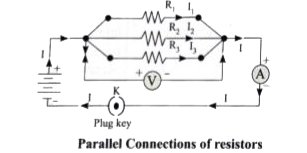(a) (i) State Ohm's law.
(ii) With the help of a circuit diagram derive the formula for the resultant resistance of three resistances connected in parallel. Solution in Tamil
According to Ohm.s law, at a constant temperature, the steady current .I. flowing through a conductor is directly proportional to the potential difference .V. between the two ends of the conductor.
1∝V.∴V=1R
(a)(ii)Resistors in Parallel: A parallel circuit has two or more loops through which current can pass. If the circuit is disconnected in one of the loops, the current can still pass through the other loop(s). The wiring in a house consists of parallel circuits.

(i) Consider that three resistors R1R2 and R3 are connected across two common points A and B.
(ii) The potential difference across each resistance is the same and equal to the potential difference between A and B. This is measured using the voltmeter.
(iii) The current I arriving at A divides into three branches I1,I2, and I3, passing through R1R2 and R3 respectively.
According to the Ohm’s law we have
I1=VR1 ……(1)
I2=VR2...(2)
I3=VR3...(3) The total current through the circuit is given by I=I1+I2+I3
Using equation (1),(2) and (3) we get
I=(V)(R1)+(V)(R2)+(V)(R3)......(4)
Let the effective resistance of the parallel combination of resistors be Rp. Then, I=VRp...(5)
VRp=(V)(R1)+(V)(R2)+(V)(R3)
1Rp=(1)(R1)+(1)(R2)+(1)(R3)
Thus
(iv)When a number of resistor are connected in parallel the sum of the reciprocals of the individual resistance is equal to the reciprocal of the effective or equivalent resistance.
(v)When ‘n’ resistor of equal resistance R are connected in parallel the equivalent resistance is Rn
i.e 1Rp=(1)(R)+(1)(R)+(1)(R)........+1R=nR
Hence Rp=Rn
(vi) The equivalent resistance in a parallel combination is less than the lowest of the indiviuasal resistances.
Topper's Solved these Questions
- SAMPLE PAPER -8Book:FULL MARKSChapter:SAMPLE PAPER -8Exercise:Part-III
Explore 10 Videos
- SAMPLE PAPER -15 (UNSOLVED)Book:FULL MARKSChapter:SAMPLE PAPER -15 (UNSOLVED)Exercise:PART - IV
Explore 2 Videos
- SAMPLE PAPER 04 (SOLVED)Book:FULL MARKSChapter:SAMPLE PAPER 04 (SOLVED)Exercise:PART-IV
Explore 6 Videos
Similar Questions
Deduce the equation of a force using Newton's second law of motion .
View Solution(i) Two bodies have a mass ratio of 3:4 The force applied on the bigger mass produces an acceleration of 12ms−2. What could be the acceleration of the other body, if the same force acts on it.
(ii) A cricket ball of mass 100 g moving with a speed of 20ms−1 is brought to rest by a player . Find the change in momentum of ball.
View SolutionExplain the construction and working of a 'Compound Microscope'.
View SolutionState Ohm's law. Derive an expression for the equivalent resistance of a number of resistances in parallel.
View Solution(a) With the help of a diagram, derive the formula for the resultant resistance of these resistors connected in series. (b) For the circuit shown in the diagram given below: Calculate: (i) the value of current each resistor. (ii) the total current in the circuit. (iii) the total effective resistance of the circuit.
View Solution(a) With the help of a circuit diagram, obtain the relation for the equivalent resistance of two resistances connected in parallel. (b) In the circuit diagram shown below, find: (i) Total resistance. (ii) Current shown by the ammeter A
View SolutionState Ohm's law. How can it be verified experimentally ? Explain with the help of a circuit diagram. Express the result graphically.
View SolutionWith the help of a circuit diagram derive the formula for the resultant resistance of three resistances connected:a) in series and b) in parallel.
View Solutionपार्श्वक्रम में जुड़े, तीन प्रतिरोधों का परिपथ चित्र बनाइए। इस संयोजन के तुल्य प्रतिरोध के सूत्र की व्युत्पत्ति कीजिए।
View SolutionWith the help of a circuit diagram derive the formula for the resultant resistance of three resistance connected : (a) in series and (b) in parallel
View SolutionWith the help of a circuit diagram derive the formula for the resultant resistance of three resistances connected in series.
View SolutionState Ohm's law. Derive the laws of resistances, when they are connected: (i) in series (ii) in parallel.
View SolutionState Ohm's law. How can it be verified experimentally ? Explain with the help of a circuit diagram. Express the result graphically.
View SolutionState Ohm’s law. Derive the laws of resistance, when they are connected in parallel.
View SolutionState the law of combination of resistances in series and draw a circuit diagram containing three resistors connected in series.
View Solution
